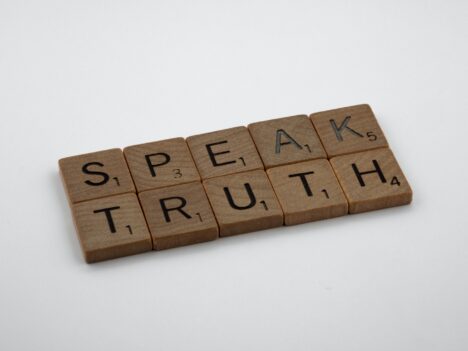
American President Joe Biden was obviously upset with Meta when, in mid 2021, he accused it of “killing people” for its seeming tolerance of so much Covid-19 misinformation. He backed down a little by clarifying that he wasn’t blaming Facebook itself, but the “bad information” they allowed on the site.
Meta reported, perhaps in response, that it had removed more than 20 million posts on Facebook and Instagram for “violating rules on Covid19 misinformation since the beginning of the pandemic”.
Social media platforms often portrays the unbelievable as fact. Two Covid-related stories from Australia had worldwide impact after turning up on social media during the pandemic.
On August 18, 2021, American broadcaster Stew Peters and Republican candidate DeAnna Lorraine posted a video to Instagram titled: “2 Kids DEAD after 24,000 children herded into stadium for JAB!”
Peters claimed a former member of the Australian military told him that two students had died in a vaccination drive in Sydney, Australia.
“Two kids already dead, subsequent to this injection, in the stadium where they were ushered in and assured everything would be okay,” he said. Within 24 hours the video had gained more than 20,000 views. To be fair, the vaccination drive did happen. The actual number of students vaccinated was 15,390, but no-one actually died.
Then there was the false claim that 1.5 million people marched on Australia’s national capital, Canberra, on February 12, 2022, for a “Freedom March ” mainly against vaccine mandates. For starters, 1.5 million from a population of 26 million is about 5 percent of the population, and an incredible feat when 94.3 percent of Australians aged 16 and over are fully vaccinated.
Police estimated the crowd at about 10,000. This was contradicted by a Facebook user who posted an aerial photo of a much larger crowd—closer to a million. However, there was a problem. Anyone who knows anything about Canberra (I lived there for four years) would recognise the photo as being nowhere near Parliament House where the protest was held. In fact, it was a photo of the 1969 Woodstock Festival in the United States.

(Credit: Getty Images)
Living in a post-truth world
We live in what has been called a post-truth world. In 2016, “post-truth” was announced as the Oxford Dictionary’s word of the year. Its usage had increased by 2000 per cent over the previous year.
Post-truth is: “Relating to or denoting circumstances in which objective facts are less influential in shaping public opinion than appeals to emotion and personal belief.”
Casper Grathwohl, president of Oxford Dictionaries, recalled the Brexit vote in the United Kingdom and the election of Donald Trump in the United States as the cause and added, “I wouldn’t be surprised if post-truth becomes one of the defining words of our time.”
For Trump, the Washington Post Fact Checker claims that he made 30,573 “false or misleading” claims as president—almost half in his final year. More significant was a response from Scottie Nell Hughes—a Trump spokesperson—when she was asked about his claim on Twitter that he would have won the popular vote in 2016 if millions of immigrants had not voted illegally.
Her response? “There’s no such thing, unfortunately, anymore, as facts.”
She argued that it isn’t whether his fraud claim is true, but who believes it: “Mr Trump’s tweet[s], amongst a certain crowd . . . are truth . . . and people believe they have facts to back that up. Those that do not like Mr Trump, they say that those are lies, and there’s no facts to back it up.”
If there is no such thing as objective truth or facts, that is scary. So, how do we become truth-tellers when surrounded by fake news in the social media world? Here are five suggestions:
#1 BE CRITICAL
In May 2019, a video on social media showed Nancy Pelosi, the Speaker of the United States House of Representatives, stammering and slurring her speech, causing many to question her mental aptitude—or that she was drunk. The reality was that the video had been doctored to give that appearance—and that Pelosi does not drink alcohol.
In this case, any who have seen her in action would find it difficult to match the video with reality. No matter what your politics, she’s a sharp woman and a strong leader. This was so out of character and needed critical investigation to find out if there was an explanation.
When we accept a post like this at face value—and like or forward it—we become part of the fake news problem.
#2 WAIT
Before you pass on that unbelievable post, wait. There’s an old saying that a lie can travel halfway around the world while truth is putting its shoes on. Waiting gives truth a chance to get its shoes on and you the chance to mull over what to do. Passing it on could perpetuate a harmful lie. Weigh up your responsibility for good or for evil before passing on a post.
“Misinformation flourishes most when people are fearful, angry and uncertain,” says Suzannah Gonzales, from the News Literacy Project. That calls for us to be aware of our emotions and slow down to make sure we don’t send or click on a post we regret later. We know there’s pressure to be the first to pass on something that’s outrageous, but when dealing with people, we need thought and compassion.
#3 THINK LIKE A JOURNALIST
Do you know the person who sent the original post? If yes, are they trustworthy? If not, what can you discover about them? Is there a particular bias on their site? Does the style come across as fair and balanced?
You can also do your own research about posts that seem suspicious. factcheck.afp.com is a trusted source for journalistic fact-checking, as is Politifact.com. I found both helpful in researching for this article—and there are others. Of course, fact checkers don’t have instant responses because it takes time to work through the process. This calls for patience.
#4 HAVE YOUR OWN DEPENDABLE NEWS SOURCE
Whether it’s an online source, a radio or television source, or the now old-fashioned kind, newsprint, you should have a dependable news source. A good guide is if it will tell you when they get something wrong.
American telecommunications conglomerate Verizon puts it this way: “News sources develop reputations based on the quality and consistency of their news reporting, particularly when it comes to fact-checking and presenting a balanced perspective of issues. There are both reliable and unreliable news sources, and it’s important to assess the credibility of a source when trying to determine the verisimilitude (truth) of its content.”
#5 BE CHRISTIAN
If you are a follower of Jesus—the Way, the Truth and the Life (John 14:6)—you are called to be like Him—truthful. In contrast, the devil has no truth in him (John 8:44). In the Ten Commandments we’re called to not “testify falsely” against our neighbour (Exodus 20:16, NLT. This includes our digital neighbour. We should know the truth before commenting. Then there’s: “Let everything you say be good and helpful, so that your words will be an encouragement to those who hear them” (Ephesians 4:29, NLT).
Social media can be a useful connecting tool. It can be playful and entertaining. It can be inspirational. It can be positive. Yet there’s also much that’s questionable. For the questionable, we can make a difference—by not rewarding it with clicks and shares. The best response to the negative and questionable is often no response.
It’s time we took pride in saying, “Yes, I saw that, but I think it made that individual look foolish and I didn’t want to share something they may later regret.” That has heart—more heart than counting the number of clicks you get from a response.
Bruce Manners is an author, retired pastor and former editor of Signs of the Times based in Lilydale, Victoria.









